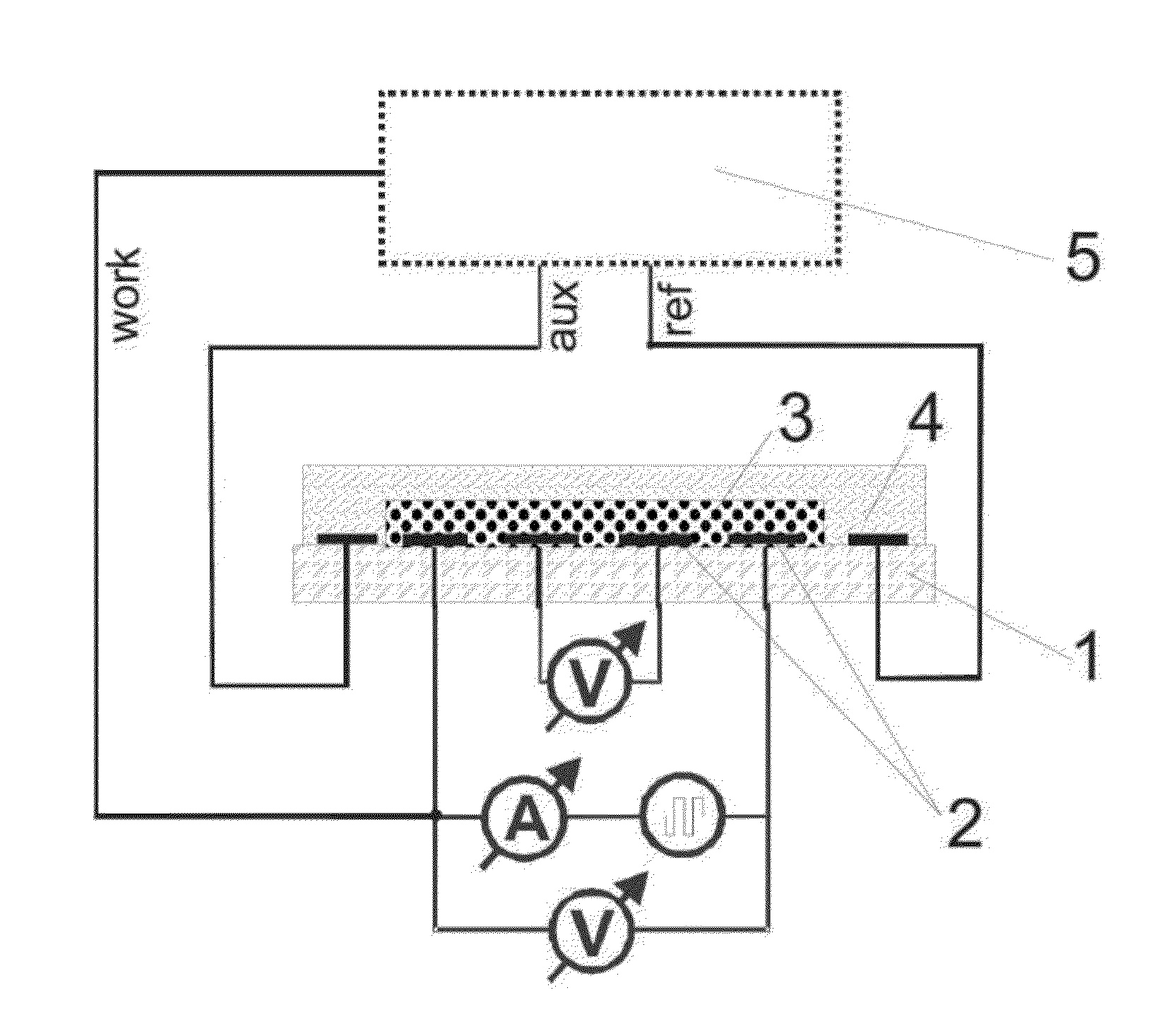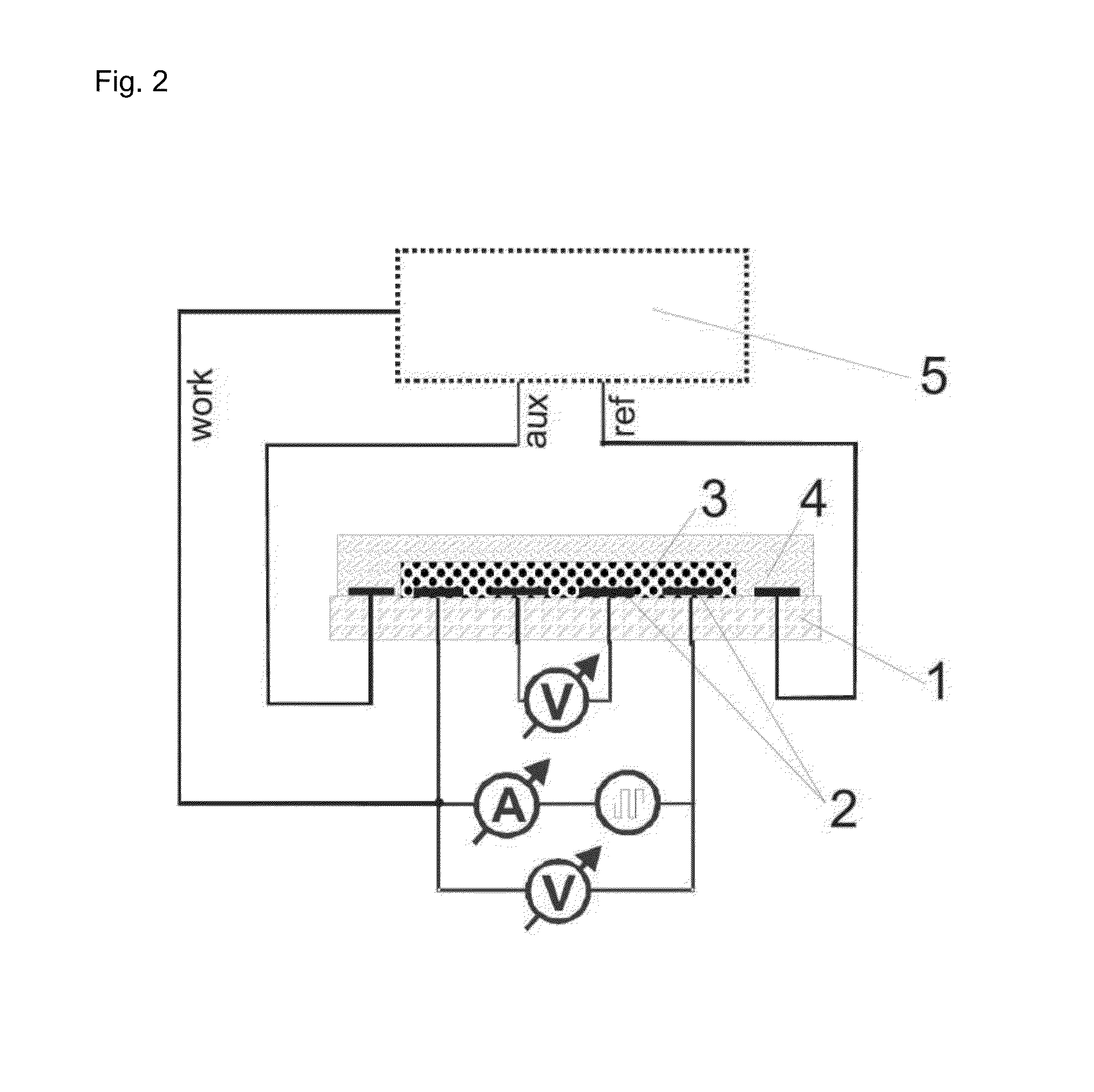Multi-electrode chemiresistor
a chemiresistor and multi-electrode technology, applied in the field of multi-electrode chemiresistors, can solve the problems of conductivity becoming sensitive to parameters, reducing the sensitivity of chemiresistors, and complicating these methods
- Summary
- Abstract
- Description
- Claims
- Application Information
AI Technical Summary
Benefits of technology
Problems solved by technology
Method used
Image
Examples
example 1
Preparation of the Electrode and Testing
[0088]The electrodes presented in FIGS. 3 and 4 were used. The thickness of each electrode in this example was 150 nm of gold on a 15 nm adhesive layer of titan / wolfram applied on glass. This system (as described in Lange et al, J. Electroanal. Chem. 622, 246, 2008) was used in order to measure the 4- and 2-point resistance simultaneously and to calculate the contact and film resistances. A potentiostat “radiometer PGSTAT 201” was used in order to control the redox-state of the chemosensitive material.
[0089]The reference electrode was modified through electro-chemical reduction from silver (precipitation by −0.44 V vs CuSO4 from a solution of 0.1 M AgNO3 and 0.2 M EDTA which contains 1.5 M NH3). The electrode is thereafter covered with silver chloride (oxidation of the silver in 0.1 M HCl at 1 V vs Ag / AgCl). The auxiliary electrode and the work electrode are electro-chemically modified with polythiophene (polymerization at 1.35 V vs Ag / Ag+ fro...
example 2
Measurement of a Gas Analyte
[0090]The electrodes which were produced according to example 1 were used for the detection of highly diluted NO2. The results of the measurement are demonstrated in FIG. 6. The exposure of a sensor to NO2 containing air leads to an oxidation of the polythiophene into a dropping resistance. The spontaneous regeneration via flushing with air is very slow, whereby a short pulse with a cathodic voltage leads to the fast reduction of the chemosensitive material and leads to the regeneration of the sensor completely. The regeneration process can be carried out repeatedly (FIG. 6).
example 3
Preparation of the Sensor for Spectroscopy
[0091]The electrodes which are described in example 1 are used for the reflection spectroscopy experiments. The potential is controlled through the potentiostat “radiometer PGSTAT 201”. Changes in the optical spectrum after exposure to analytes are measured by the spectrophotometer with the assistance of fibre optics. The samples for the transmission spectroscopy are produced on the surface of indium-tin-oxide covered glass (FIG. 7). The indium-tin-oxide-layer is structured through the mechanical separation of the conductive layer. The measurement was carried out using a spectrophotometer.
[0092]For pH-measurements polyanilin or polypyrol is used as the sensitive layer. The measurements are carried out at constant potential.
PUM
| Property | Measurement | Unit |
|---|---|---|
| current/voltage drop | aaaaa | aaaaa |
| thick | aaaaa | aaaaa |
| frequency | aaaaa | aaaaa |
Abstract
Description
Claims
Application Information
 Login to View More
Login to View More - R&D
- Intellectual Property
- Life Sciences
- Materials
- Tech Scout
- Unparalleled Data Quality
- Higher Quality Content
- 60% Fewer Hallucinations
Browse by: Latest US Patents, China's latest patents, Technical Efficacy Thesaurus, Application Domain, Technology Topic, Popular Technical Reports.
© 2025 PatSnap. All rights reserved.Legal|Privacy policy|Modern Slavery Act Transparency Statement|Sitemap|About US| Contact US: help@patsnap.com



